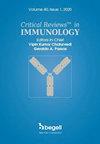对雌激素受体丝氨酸对其功能和乳腺生长的影响
IF 0.9
4区 医学
Q4 IMMUNOLOGY
引用次数: 0
摘要
背景:雌激素受体(ER)信号在乳腺发育和功能分化过程中发挥着重要作用,并参与乳腺癌的发生过程。激活的雌激素受体可通过调节许多下游靶基因的表达,影响细胞行为的各个方面,包括增殖。磷酸化是ER的激活途径之一。然而,雌激素受体磷酸化位点与乳腺发育和癌变之间的关系尚不清楚:方法:利用Crisper-Cas9基因编辑技术,我们构建了ER S309A突变小鼠。方法:我们利用 Crisper-Cas9 基因编辑技术构建了ER S309A 突变小鼠,利用胭脂红染色法检测了不同发育阶段小鼠乳腺的发育情况。通过对连续5天同一时间的小鼠阴道涂片进行HE染色,我们测定了阴道上皮角质细胞:结果:我们建立了ER S309A突变小鼠,并观察到ER S309A小鼠的乳房缺陷。此外,我们还观察到ER S309A小鼠生殖能力下降、发情周期紊乱。ER S309A小鼠发情周期中阴道上皮角质细胞数量减少:这些结果表明,ER丝氨酸309的磷酸化位点对ER功能和乳腺发育非常重要。本文章由计算机程序翻译,如有差异,请以英文原文为准。
Effect of p-estrogen receptor at serine on its function and breast growth
Background: Estrogen receptor (ER) signaling plays an important role in the development and functional differentiation of breast and participates in the process of breast cancer. Activated ER can affect various aspects of the cell’s behavior, including proliferation, via modulating the expression of many downstream target genes. Phosphorylation is one of the activation pathways of ER. However, the relationship between estrogen receptor phosphorylation sites and breast development and carcinogenesis is not clear.
Methods: Using Crisper-Cas9 gene editing technology, we constructed ER S309A mutant mice. Using carmine staining of mammary gland of mice at different developmental stages, we examined breast development of ER S309Amice. Using HE staining of vaginal smears of mice at the same time for 5 consecutive days, we measured the vaginal epithelial keratinocytes.
Results: We established ER S309A mutant mice and observed breast defects in ER S309A mice. In addition, we observed decreased reproductive ability, estrous cycle disorder in ER S309A mice. And number of vaginal epithelial keratinocytes in the estrous cycle of ER S309A mice was decreased.
Conclusion: These results suggest that phosphorylation site of ER at serine 309 is important for ER function and breast development.
求助全文
通过发布文献求助,成功后即可免费获取论文全文。
去求助
来源期刊
CiteScore
2.60
自引率
0.00%
发文量
14
审稿时长
>12 weeks
期刊介绍:
Immunology covers a broad spectrum of investigations at the genes, molecular, cellular, organ and system levels to reveal defense mechanisms against pathogens as well as protection against tumors and autoimmune diseases. The great advances in immunology in recent years make this field one of the most dynamic and rapidly growing in medical sciences. Critical ReviewsTM in Immunology (CRI) seeks to present a balanced overview of contemporary adaptive and innate immune responses related to autoimmunity, tumor, microbe, transplantation, neuroimmunology, immune regulation and immunotherapy from basic to translational aspects in health and disease. The articles that appear in CRI are mostly obtained by invitations to active investigators. But the journal will also consider proposals from the scientific community. Interested investigators should send their inquiries to the editor before submitting a manuscript.

 求助内容:
求助内容: 应助结果提醒方式:
应助结果提醒方式:


